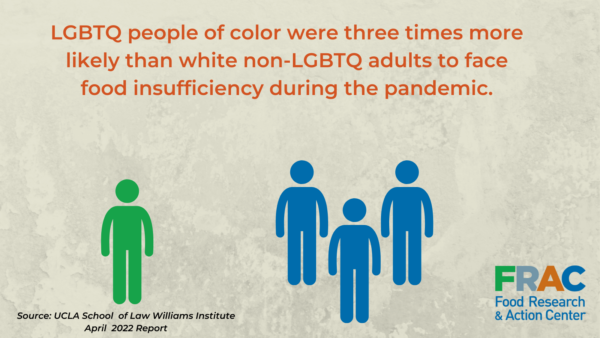This Pride month, FRAC is excited to be joining the National Center for Lesbian Rights (NCLR) in releasing a new two-part resource (quick facts sheet, programs chart) to help connect LGBTQ individuals and families with low incomes to key federal nutrition programs.
Hunger and Poverty in LGBTQ Communities
LGBTQ individuals and families have long experienced higher rates of poverty and hunger, with struggles to obtain economic security at times exacerbated by additional barriers such as discrimination and family rejection. Before the COVID-19 pandemic, 27 percent of LGBT people reported experiencing food insecurity, according to an analysis of 2017 Gallup data by the Williams Institute. The analysis also found that certain segments of the LGBT population experienced higher rates of food insecurity, including young adults, women, and Black, Latinx, American Indian, and Pacific Islander LGBT people.
During the economic and health crises spurred by the COVID-19 pandemic, these hardships deepened. However, the lack of data collection related to LGBTQ status made it difficult to see the full extent of hardship during much of the pandemic. For instance, the Household Pulse Survey, designed to measure household experiences during the pandemic, initially did not have questions related to sexual orientation or gender identity.
In July 2021, the U.S. Census Bureau made the essential addition to the Household Pulse Survey to include questions on sexual orientation and gender identity — allowing for more nuanced data on the experience of LGBTQ households, including experiences of food insufficiency, during the pandemic.
During the period July 21–October 11, 2021, 12.7 percent of LGBT respondents reported experiencing food insufficiency, compared with 7.8 percent of non-LGBT adults. Certain LGBT people had heightened rates of food insufficiency, including 17 percent of LGBT people of color and 20 percent of transgender adults.
Spreading the Word on Federal Nutrition Programs
These stark data underscore the importance of connecting LGBTQ individuals and families with low incomes to federal nutrition programs, such as the Supplemental Nutrition Assistance Program (SNAP), WIC, school and out-of-school time programs, and home-delivered and congregate meal programs. These programs are proven to address hunger, improve nutrition, health, and well-being, as well as spur economic activity.
FRAC and NCLR’s new resource helps organizations who work with LGBTQ communities ramp up their knowledge about programs available across the lifespan. This resource includes:
- A quick facts sheet that highlights key considerations on accessing nutrition programs for LGBTQ households. The resource also highlights how providers may be able to leverage programs, such as the summer meals programs, to serve healthy meals to LGBTQ youth they serve.
- A federal nutrition program chart that overviews the range of programs available by age group to help providers quickly assess what programs are available to the people they serve. It includes basics on program operations, eligibility, and where to learn more and apply. It also includes an opportunity for organizations to add customized information on local resources available in their community.
Actions for Advocates
Anti-hunger advocates have an important role to play in addressing hunger among LGBTQ communities.
- Forward the federal nutrition program resource: Customize and share the federal nutrition program resource (quick facts sheet, programs chart) with providers who serve LGBTQ communities in your area on your social media channels and beyond.
- Elevate your partnerships: Join NCLR and FRAC as a member of the National LGBTQ Anti-Poverty Action Network and connect with LGBTQ centers or organizations in your state.
- Dive into the data: Get to know the research and data on LGBTQ poverty and hunger, as well as essential opportunities to enhance data collection.
- Push for protections:
- Engage with your state SNAP agency on implementation of the U.S. Department of Agriculture’s (USDA) recent strengthening of civil rights protections related to gender identity, including gender expression, and sexual orientation. Learn more about the enhanced protections and actions to take with these FRAC blogs:
- Support passage and implementation of non-discrimination protections at the local, state, and federal level. The need for such protections is particularly apparent at this time of heighten legislative attacks on LGBTQ people, especially transgender children. You can learn more about the state of LGBTQ-related laws and policies with the Movement Advancement Project’s Equality Maps. See this fact sheet on the new Executive Order on Advancing LGBTQI+ Equality for ways the administration is fighting discrimination.
- Share #MyHungerSolution to prepare for this September’s White House conference: Access the FRAC toolkit for tips for getting involved in the White House Conference on Hunger, Nutrition, and Health. FRAC’s website provides background and updates on conference planning and opportunities for input from advocates and from people with lived experience with hunger and poverty, including LGBTQ people.




